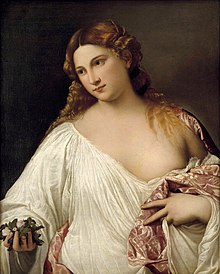Flora (Titian)
painting by Titian
Flora is an oil painting by Italian late Renaissance painter Titian, dated to around 1515 and now held at the Uffizi Gallery in Florence. The subject is the Roman goddess of flowers.


Quotes
edit- The popular Flora of the Uffizi, a beautiful thing still, though all the bloom of its beauty has been effaced, must be placed rather later in this section of Titian's life-work, displaying as it does a technique more facile and accomplished, and a conception of a somewhat higher individuality. The model is surely the same as that which has served for the Venus of the Sacred and Profane Love, though the picture comes some years after that piece.
- Claude Phillips, The Earlier Work of Titian (1897), p. 52.
- [T]he "Flora" is attuned to a scale of golden and light violet tones.Titian puts forth the highest art of his palette to present in all her splendour this magnificent model, who had fascinated his artistic nature. No one before him, and few after him, have succeeded in rendering with such an impression of softness the full form coming out of the white, gold-bordered chemisette; and probably Titian alone, in later life, more freed from everything material, was able to reproduce the subtle play of light on fair hair. This magic charm of artistic power, which rises far above mere technical skill, has to compensate us for the absence of any indication of individual character in the features, which, as, for instance, notably in the "Flora," are curiously devoid of expression. Who could blame Titian that his painter's eye was attracted and that he caught his inspiration from the perfection of mere physical beauty?Probably he was thinking of this and of other creations of the kind, also belonging to his later years, when he once remarked, as Pietro Aretino reported to Vasari, "that he never saw a maiden without discovering in her features a touch of sensuality" ("lascivia"). He has neither veiled nor toned down this "touch" in his pictures—he set himself each time a colour problem and solved it, without reflecting upon problems of morality.
- Georg Gronau, Titian (1904), pp. 45–6.
- [T]he technical aspect of the 'Flora' (or what remains of it) belongs to an earlier phase of Titian's career than might be surmised from the reproduction, and the over placid and almost animal expression in this symmetrical face.
- We can admire among the better-preserved portions of the 'Flora' the fine tresses on the shoulder, the linen and hueless brocade round the right hand.
- Charles Ricketts, Titian (1910), pp. 53, 54.